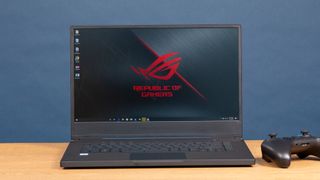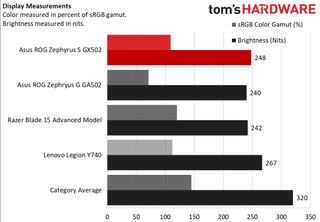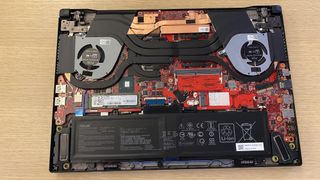Tom's Hardware Verdict
The ROG Zephyrus S GX502 packs tons of power in as tight of a 15.6” package as possible, but at the detriment of cooling efficiency.
Pros
- +
Thin design
- +
Clean durable build
- +
Great gaming performance
Cons
- -
Loud fans
- -
RAM soldered down
- -
No webcam
Why you can trust Tom's Hardware
Some laptops do an excellent job of combining power and space efficiency. The Asus ROG Zephyrus S S GX502 ($2,099.99 as tested) is among them. Our unit sported an Intel Core i7-9750H and an Nvidia GeForce RTX 2070 GPU in its compact case. That comes with some compromises, like loud fans and soldered-on RAM. But if you value portability and power, you may consider these to be acceptable trade-offs.
Design




Asus has crammed specs typically found in chunkier laptops in something that’s far thinner. Components are housed in a chassis made of machined magnesium-aluminum alloy and wrapped in a soft-touch paint. The GX502 is plenty rigid and there’s very little flex in the keyboard deck. Notably, though, the GX502’s screen flexes significantly when torqued.
The GX502’s calling card is its ability to open up and allow more airflow. It’s definitely a cool party trick, and it allows the laptop to pull more air into its slim package. The glowing RGB lights underneath add to the “gamer” vibe.
There’s a wide selection of ports, including Ethernet, HDMI, a USB Type-A port, headphone and microphone jacks on the left side, and a Type-C port and two more USB ports on the right side.
Bezels have been paired down substantially from last year’s model and give the screen the illusion of being bigger than it actually is. It also means that the laptop has a slightly smaller footprint when compared to other 15.6-inch devices.
Below the screen are three LED indicator lights that sit at the top of an array of dots. While these dots look like a speaker grill, there are no speakers underneath this pattern. Speakers instead are toward the front of the machine and fire downwards.
When the laptop is closed, those same LED lights are still visible thanks to Asus’s clever panel design. The screen is lifted slightly to allow for a slight gap in which the lights can shine through.
At 14.2 x 9.9 x 0.7 inches and 5.1 pounds, the Zephyrus is similar in size to the Asus ROG Zephyrus G GA502, an AMD-based machine (though that model is lighter). The Razer Blade 15 Advanced Model is smaller at 4.7 pounds and 14 x 9.3 x 0.8 inches, and the Lenovo Legion Y740 is 5 pounds and 14.2 x 10.5 x 0.9 inches.
Specifications
| CPU | Intel Core i7-9750H |
|---|---|
| Graphics | Nvidia GeForce RTX 2070 |
| Memory | 16GB DDR4-2666 |
| SSD | 1TB M.2 PCIe NVMe SSD |
| Display | 15.6-inch, 1920 x 1080, 240 Hz |
| Networking | Intel Wireless-AC 9560, Bluetooth 5.0 |
| Ports | 3x USB 3.1 Type-A, USB 3.1 Type-C, HDMI 2.0b, Headphone jack, microphone jack, Ethernet |
| Camera | No webcam |
| Battery | 76WHr |
| Power Adapter | 230W |
| Operating System | Windows 10 Pro |
| Dimensions (WxDxH) | 14.2 x 9.9 x 0.7 inches |
| Weight | 5.1 pounds |
| Price (as configured) | $2,099.99 |
Gaming and Graphics

Our review unit came with an Nvidia RTX 2070 GPU, a powerful card that can play most games at high settings. When playing Control, a graphically demanding title, the RTX 2070 was able run the game between 50-60 fps with all the settings maxed out at 1080p. Turning down a few graphical settings slightly will yield a more uniform experience. During testing, the fans inside the GX502 were spinning fast and loud to dissipate heat.
Setting ray tracing on high had a huge impact on performance, causing noticeable stuttering. But on medium, Control was playable at around 40 fps.



On the Shadow of the Tomb Raider benchmark (highest settings, 1080p), the Zephyrus S ran the game at 46 fps. That’s below the premium gaming average (66 fps, which includes some systems with more powerful GPUs), but better than the Legion (RTX 2070 Max-Q), Blade (RTX 2080 Max-Q) and AMD-based Zephyrus (GTX 1660 Ti).
We also ran the Grand Theft Auto V benchmark (very high, 1080p). The Zephyrus S ran at 76 frames per second, just under the average (80 fps). The Razer Blade 15 was faster (86 fps), but the other competitors were slower.
On Middle-earth: Shadow of War’s benchmark, the Zephyrus ran at 78 fps, trailing the Legion and the Blade as well as the average (97 fps).
On our Metro Exodus stress test, in which we run the benchmark 15 times at RTX settings, the average CPU clock speed was 3.7GHz, pushing the Core i7-9750H to 79.9 degrees Celsius (175.8 degrees Fahrenheit). GPU clock speeds were an average 1.2GHz at 70.7 degrees Celsius(159.3 degrees Fahrenheit). Across those runs, the benchmark played at an average of 47.7 fps.
Productivity Performance
With an Intel Core i7-9750H, 16GB of RAM and a 1TB SSD, our review unit is also powerful enough for serious productivity use.



On Geekbench 4.3, the Zephyrus S notched a score of 19,639. That’s better than the Ryzen 7 3750H-based GA502 (14,106) but less than the average (25,010), the Blade and the Legion.
The Zephyrus S took 7 seconds to transfer 4.97GB of files on our file transfer test. That’s 727 MBps, the same rate as both the AMD model and the Razer Blade 15 Advanced. The Legion was slower at 565.5 MBps.
On our Handbrake video editing test, the Zephyrus S transcoded a 4K video to 1080p in 12 minutes and 44 seconds. That’s faster than the Zephyrus G and the Blade, but not the Legion.
Display

The 15.6 inch FHD, 244 Hz, display on the Asus ROG Zephyrus S GX502 offers solid performance. This is especially excellent for games where frames matter, like Counter-Strike: Global Offensive or Street Fighter V.
Rocket League, with its bright oranges and blues, looked fine. It didn’t pop the same way it does on the Xbox One version of the game, which has HDR support. But blues looked deep enough while oranges were a bit dull.
The display encompasses 109.4% of the sRGB color gamut. That’s less than the premium gaming average (145%) as well as the Legion (112%) and Blade (120%). Notably, it’s far better than the screen on the AMD model (71%).

The Zephyrus S’ panel gets decently bright at 248.2 nits, and is better than the Zephyrus G and the Razer Blade, but dimmer than the Legion.
Keyboard and Touchpad

Typing up this review on the GX502’s keyboard was a satisfyingly clicky experience. It’s not a mechanical keyboard by any means, but there’s a noticeable actuation and rebound to every key press. The keys are large and spaced apart well enough so that there are seldom any missed inputs.
The keyboard is also fully RGB, and easily customizable with Asus’s Armory Crate software. There’s a dedicated Armory Crate button on the device which comes in handy. And speaking of dedicated buttons, Asus has added volume controls, screen brightness controls, airplane mode, fan control, pause, rewind, and mute buttons.

The trackpad is plastic, which isn’t a bad thing, though it doesn’t match the premium feel of some ultrapotables. Asus uses Windows 10 Precision drivers, offering quick and accurate gesture response. At 4.1 x 2.8 inches, there is room for the trackpad to be wider.
Audio
I’ve praised the GX502 for its efficiency in maximizing space, but there’s one area on the device that you’d think would have been perfect for some speakers. The keyboard is surrounded by blank bits of chassis and ideally Asus could have placed some top-firing speakers next to the keyboard, rather than employing the downward-firing speakers near the front.
While the bass is good for a laptop of this size, high notes buzz and mids get muffled out. And if you’re watching Netflix in bed, it’s best to plug in headphones, as the sound will get swallowed by your blankets.
Even when the laptop is in silent mode, the hum of the fans will be a constant drone. Turn the volume up enough, and you’ll still get a decent YouTube viewing experience. But while gaming, it’s not worth cranking up the volume. Once the Xbox controller comes out, it’s best to plug in headphones or it will be like trying to listen to the radio with the windows down on the freeway.
Upgradeability

Upgrading the internals on the GX502 is involved, but fairly easy once you get inside. There are four Phillips head screws that need to be undone to remove the bottom panel. Here you’ll have access to the fans for easy cleaning. And with that first bottom panel gone, 13 more screws can be removed (except for one of those, which is captive) from the base to get access to the internals. Those screws are of a few different lenghts, so be careful to remember what goes where.
Asus has soldered on the RAM, but there’s an extra slot empty waiting to be used. There’s also an extra m.2 slot available to expand storage.
Battery Life

The Asus ROG Zephyrus S GX502 did well on our battery test, beating out all other competition in this category. The GX502 ran for an astounding 5:47 before it finally gave out. That’s more than double the Lenovo Legion Y740, and two hours more than the Razer Blade 15.
Heat


The Asus ROG Zephyrus S GX502 runs hot. We took some skin temperatures with a thermal camera while running the Metro Exodus stress test. The hottest point on the keyboard reached 45.2 degrees Celsius (113.4 degrees Fahrenheit) while the touchpad sat at a cooler 28.7 degrees Celsius (83.7 degrees Fahrenheit). Unsurprisingly, the underside of the laptop was the hottest at 55.8 degrees Celsius (132.4 degrees Fahrenheit).
Webcam
Given how prominent the bottom bezel is, you would think it would be a great place to put a webcam, like how Alienware added Tobii eye tracking to the bottom of M15 and M17. But no, a webcam does not exist on the GX502, and an external one isn’t included in the box either.
Software and Warranty
Asus hasn’t loaded the ROG Zephyrus S GX502 with too much bloatware. It does come preloaded with McAfee, so be prepared to see notifications asking you to upgrade your computer’s security. Asus’s Armory Crate software is surprisingly easy to use and is intuitive.
There are a few more gaming apps, including Sonic Studio 3 for sound and ROG Game Visual to control the screen’s color temperature. Asus sells the ROG Zephyrus S GX502 with a one-year warranty.
Configuration
Our $2,099.99 review unit came loaded with an Intel Core i7-9750H six-core processor, an Nvidia RTX 2070 GPU, a 240Hz 1080p display, 16GB of DDR4 2666MHz RAM, and a 1TB solid state drive. It’s the only configuration on sale of this writing.
Bottom Line

Asus gets it nearly all right with the ROG Zephyrus S GX502. It’s an impressively slim gaming laptop that offers excellent performance for the price. The G-Sync screen’s 240 Hz refresh rate and 3ms response time are top-notch for gaming.
However, an RTX 2070 in a thin design comes at a price. While the chassis does open up to allow for more airflow, it still gets loud. The down-firing speakers are middling, and the display, while fast, could be more vivid. If you want something slightly sleeker, the Razer Blade 15 is a good option with more configuration options, though you get a lesser-performing Max-Q GPU and the Blade costs a bit more. Overall, if you want a thin chassis with thick graphics power, the Asus Zephyrus S GX502 is a great choice.
MORE: Best Gaming Laptops
MORE: Gaming Laptop Previews
MORE: All Laptop Content
-
ashburner I’ve had this laptop since June. I also added a 16GB DIMM as well as an HP EX 950 1 TB secondary drive. I love this laptop! It has been flawless. On silent mode, I literally cannot hear anything and it would be a dealbreaker if I did. Perhaps your fans were going out?Reply -
Thw0rted The "upgrade" section showed an empty second DIMM slot. Does that mean that they tested it with the RAM running in single-channel mode? I've seen crazy numbers about the FPS impact of running in dual-channel mode -- of course it depends on the game, but more than one person has said things like "20-60%", which is enormous.Reply
I guess in a way it's Asus's fault, for soldering on one module and only selling it in 16 (single) or 32 (dual) configurations. I really don't consider it an apples-to-apples comparison, though, when you make charts where one machine is running at full potential, and the other is crippled for want of a single cheap, easy-to-install part.
